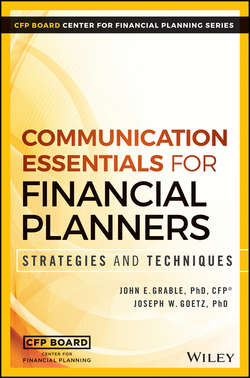Читать книгу Communication Essentials for Financial Planners - Grable John E. - Страница 8
На сайте Литреса книга снята с продажи.
Preface
MODELS OF COMMUNICATION
ОглавлениеResearchers working over the past half century have built numerous models that help explain the process of communication. Almost every model extends the basic rhetorical framework originally proposed by Aristotle, as shown in Figure P.1.
FIGURE P.1 Aristotle’s Original Communication Model
The components of the model are self-explanatory. The sender is the person who originates the interchange. The message consists of the content being delivered. The receiver is the person to whom the message is sent.
It should be clear that several important features are missing from Figure P.1. Of particular importance is the channel of exchange. In Aristotle’s time, the channel or medium of exchange tended to be either oral or written. Today, of course, there are many different channels through which two or more people can communicate. It is helpful to think of a channel matching up to one of the five senses: hearing, seeing, feeling, tasting, or smelling. Taken more broadly, the channel of communication provides a mechanism to deliver a message.
Messages are composed of information, elements (that is, words, sounds, gestures, images, and so forth); structures (that is, the composition of different elements); and codes (that is, the “language” of delivery words, tones, smells, music, and so forth).
Essentially, a sender encodes his or her message, chooses a channel to transmit the message, and sends the message. The receiver decodes the message. The decoding process will always be influenced by the receiver’s fluency in the language used by the sender and the receiver’s attitude when the message is received. Embedded in the encoding and decoding process are issues related to shared values, beliefs, language, culture, cognitive ability, experience, and knowledge. Berlo14 incorporated the concepts of sender, receiver, message, channel, encoding, and decoding to propose what he termed the SMCR communication model, which is shown in Figure P.2.
FIGURE P.2 Berlo’s SMCR Communication Model
Many adaptations to the SMCR framework have been proposed over the years. Advances include the inclusion of feedback loops from the receiver to the sender and more nuanced descriptions of encoding and decoding. This book adds to this discussion by proposing a financial planning communication and counseling skills framework. The framework was built using many of the concepts found in the SMCR model. The framework is described in more detail next.
14
D. K. Berlo, The Process of Communication (New York: International Thomson Publishing, 1960).
